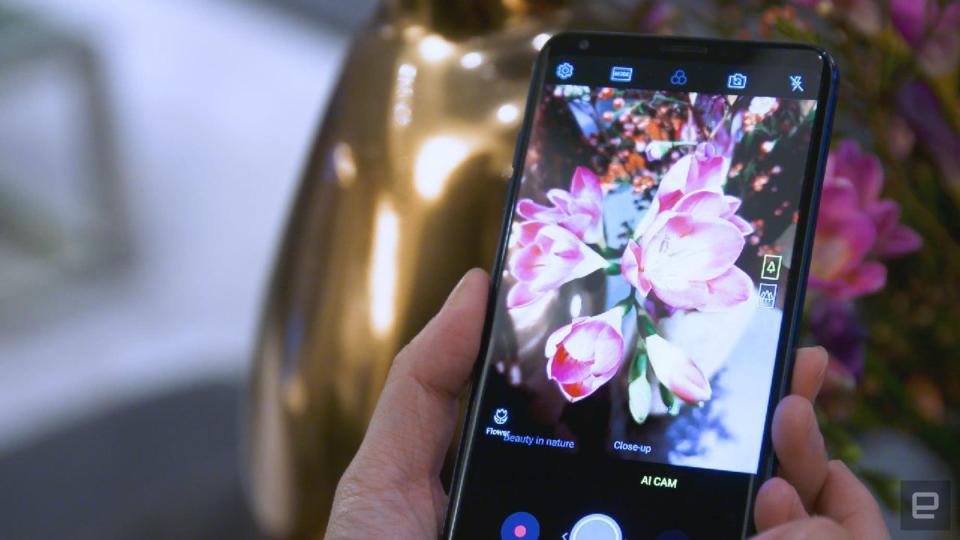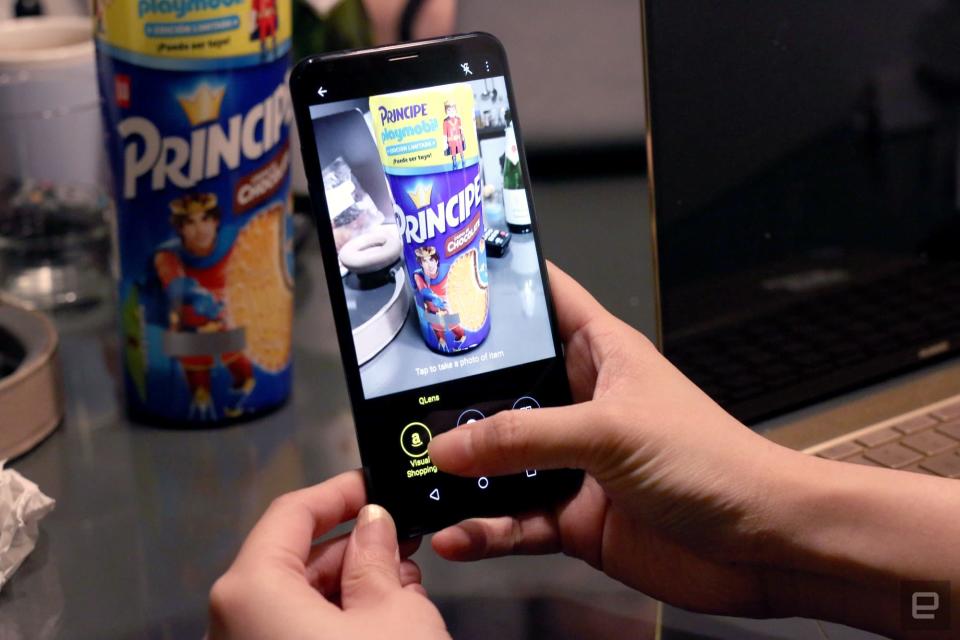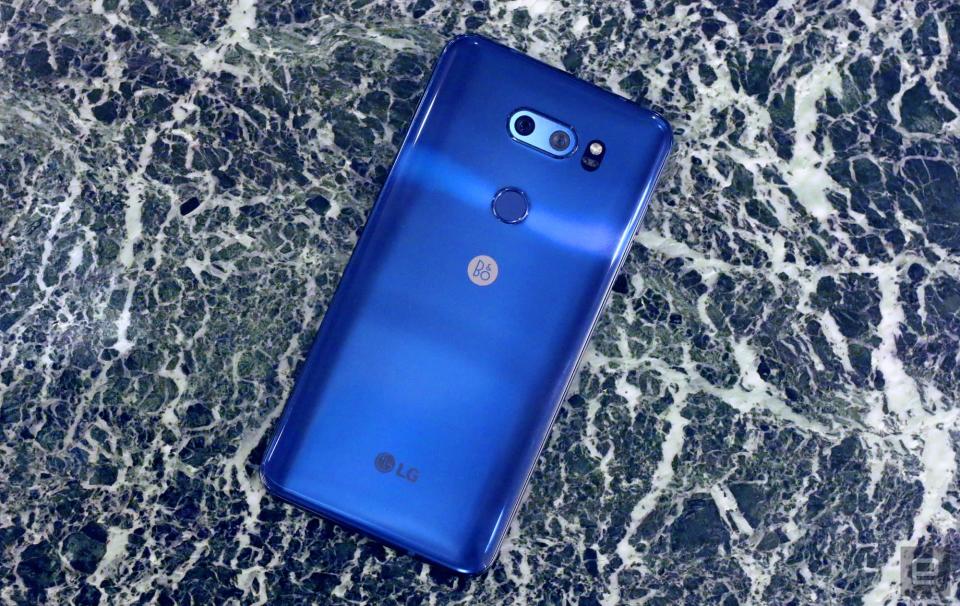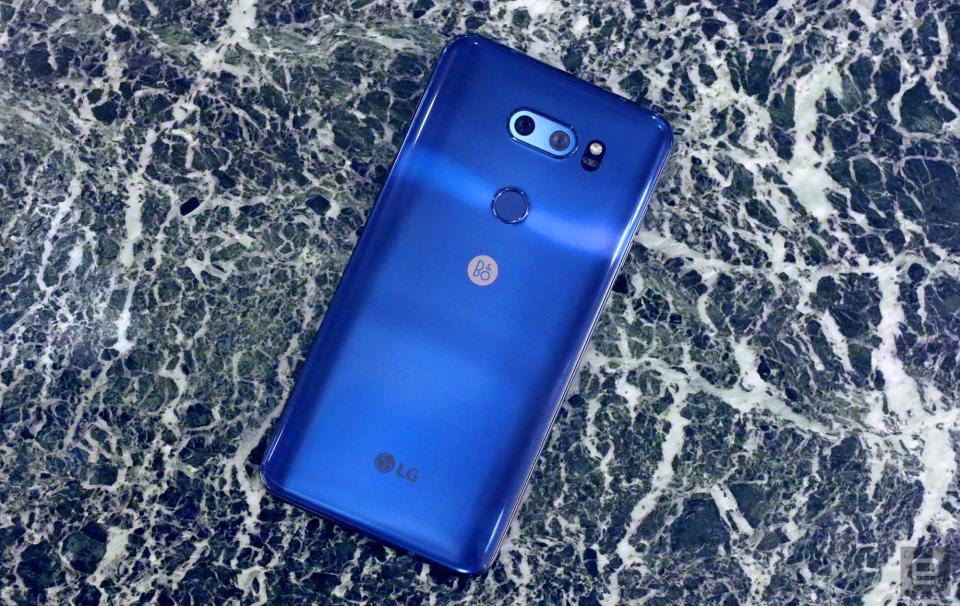LG’s V30S ThinQ is the AI-fueled phone the V30 should’ve been
This isn’t the opportunistic update we expected.
In the midst of a tricky fiscal year, LG decided to run with a new strategy: cook up interim smartphones to sell between its major flagship releases. The plan was based in part on the surprising success of phones like the X cam, and since the company needed to try something different, it pressed on with its experiment. And lo, the LG V30S ThinQ was born.
If you were looking for dramatic changes to the original V30 hardware, you might be disappointed by this "interim" release. In fact, let's run through all of the way the V30S ThinQ we received for testing differs from the original:
It has 6GB of RAM, up from 4GB.
Internal storage ranges from 128GB to 256GB, compared to 64GB-128GB in the first release.
This P-OLED display doesn't have the original's scratchy, uneven appearance in low light.
It's blue.
That's it. Broadly speaking, LG is selling last year's phone with a fancy firmware update. This news will disappoint anyone who wanted a proper G-series flagship, like the ones we got two years running here at MWC, but all of the company's messaging in the run up to the show indicated that we wouldn't get a striking, brand-new machine.
To make this whole situation even weirder, Ian Hwang (LG's director of product portfolio) confirmed that these AI features should eventually wind up on the original V30 as well. Subsequent conversations with an LG spokesperson instead suggested that some AI features would not be ported to earlier devices and that these decisions would be made on a market-by-market basis -- suffice to say, we're still trying to figure out exactly what's what.
By now, you might wondering why LG had to make a brand new version of an existing phone for these AI features to live on the first place. We're not really sure ourselves. LG has struggled to find its footing in the mobile world, so it's little surprise that the LG V30S ThinQ kinda feels like a cash-grab. It's not unlike Essential pushing out limited edition colorways to drum up some more momentum ahead of its brand new smartphone. Asking people to pay for a new version of a phone with features that are largely compatible with the original can be upsetting, but here's the thing: these AI features actually work pretty well.

LG worked with a company called EyeEm to train its image recognition algorithm on over 100 million photos, and in most of our tests, that work seems to have paid off. You'll tap into all that machine learning through the camera app, where you'll see two new options beneath the viewfinder: QLens and AI Cam. The former honestly feels like a barebones version of Bixby, with shortcuts to feed an image of what's in front of the camera to Amazon (for shopping links) and Pinterest (to add things to your visual collection).
Shopping with a visual AI is always a little tricky because you can't always count on the AI to correctly identify what's in front of it. We pointed the QLens at a box of clearly marked cereal, and a handful of correct Amazon shopping links appeared at the bottom of the screen. Nice. When we pointed it at a red sweatshirt and a MacBook Pro and even another V30, we got a handful of suggestions we could tap to see related Amazon listings. In those cases, the camera was able to roughly identify the object -- suggestions included "Apple laptop" and "LG cell phone" -- but wasn't smart enough to pin down the model and offer the correct links.

We fared a little better with QLens's Pinterest integration, though: taking a picture of a shirt prompted Pinterest suggestions that, in some cases at least, matched the shirt surprisingly well. Some suggestions were red and some had a similar texture to the real thing, so LG's algorithm was getting pretty close.
AI Cam was more immediately useful. There are eight scene mode presets -- portrait, animal, city/building, flower, sunrise, sunset, food and landscape -- and as the camera is meant to fire up whichever is appropriate for what it's looking at. While that identification process is happening, little ethereal keywords bubble up onto the screen to illustrate how the phone is "thinking" about the object. It's completely unnecessary, but just about everyone I've shown it to has enjoyed it -- it's a neat way to illustrate the algorithm in action and seeing those keywords slowly become more relevant is actually kind of fascinating.
More importantly, when objects in front of the camera -- like some flowers or donuts on a table -- matched one of the presets, the correct shooting mode kicked in just about every time. Mismatches and false positives are certainly possible, but in the few hours we've been testing the V30S ThinQ, we didn't encounter any. If anything, it just took a while for phone to decipher certain images. You don't even need to be using the dual camera for this trick to work; identifications made through the front-facing camera worked just as quickly. If LG could tune the algorithm's performance to the point where this feature could run by default, the company might really be onto something.

And then there's Google Assistant. For the most part, it works exactly the way you'd expect it to: throw an "OK, Google" or a "Hey, Google" at it, and the Assistant cheerily responds and takes your requests. The difference is, the V30S ThinQ (I will never not hate that name) is the first Android phone we've tested with device-specific Google Assistant commands. At present, there are 23 such commands, ranging from "OK, Google, take a wide-angle selfie" to "Hey, Google, take a documentary video." (For the uninitiated, the latter opens the camera with a specific Cine video mode to emulate classic docs.)
You can find the full list of commands here, and almost all of them worked exactly as designed. The experience isn't perfect, though: Google Assistant doesn't seem to understand the word "Cine" as LG uses it, so that list of commands is flawed from the get-go. And for some reason, the Assistant was never able to understand me when I said the word "noir." Go figure.
The issues I encountered were surprisingly minor, and that's made more impressive by the fact that the software on this tester phone isn't final yet. That LG (with quite a bit of help) managed to build an AI experience that functions as well as it does is no small feat, and I really wish LG had just waited and released this thing as the definitive V30 from the get-go.

LG's chosen path, however, leaves me on the fence. I honestly can't tell how crucial the extra 2GB of RAM here is to the usefulness of this AI, but either way, it feels like original V30 owners are getting a raw deal. And while I can't blame LG for trying to reverse its fortunes, interim releases like this one can be hard to swallow, especially since the first V30 only appeared on the market about six months ago. This whole interim release thing raises some questions, too: does it mean, for instance, that LG is abandoning its annual upgrade cycle? Only time will tell.
Of course, there's one other big question: should anyone actually buy this thing? That's hard to answer without an actual price tag, but one thing seems clear: there's more to LG's seemingly opportunistic update than meets the eye.
Catch up on the latest news from MWC 2018 right here.






















